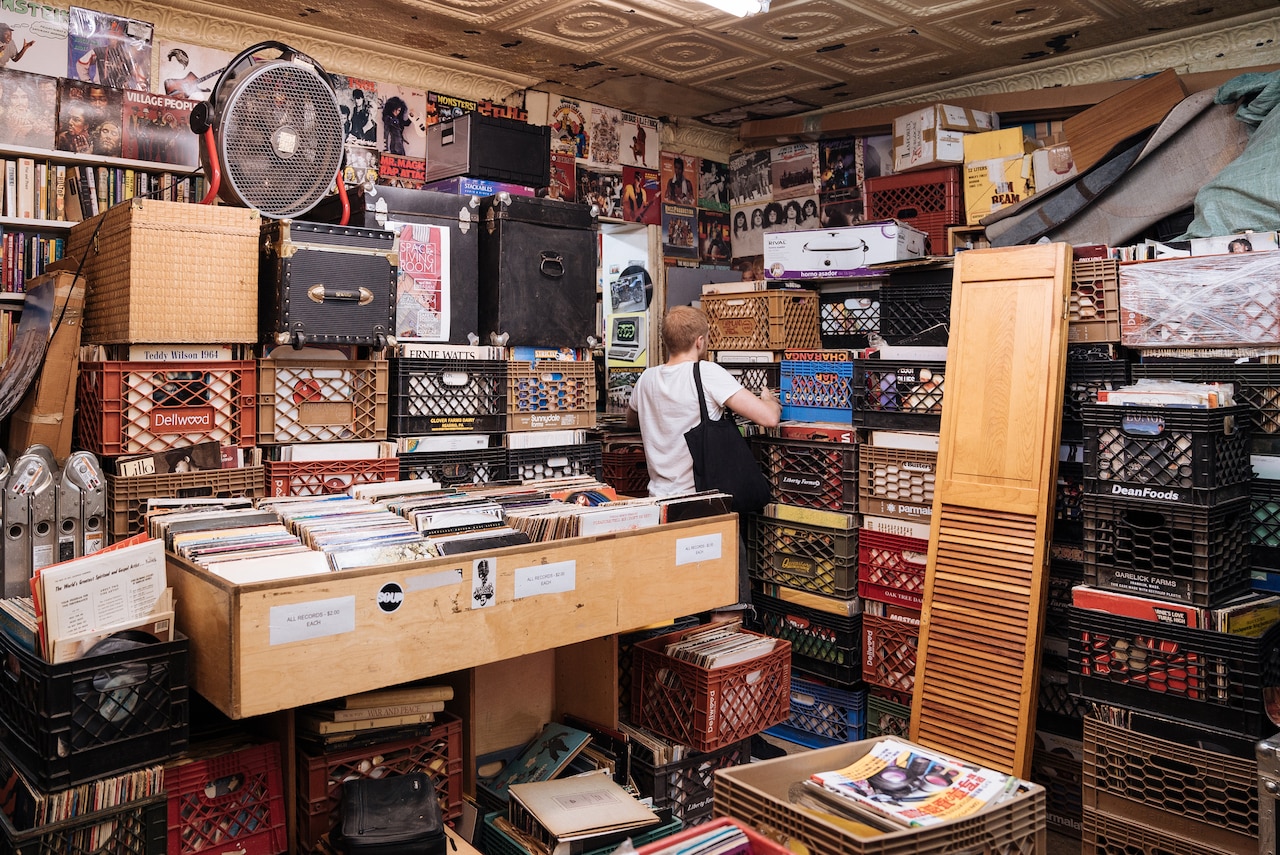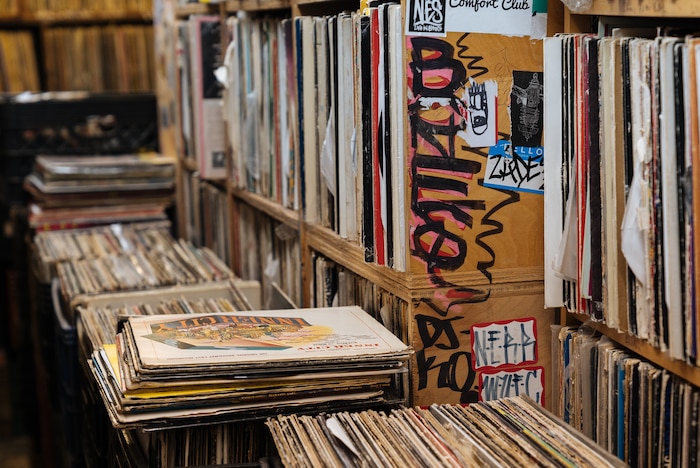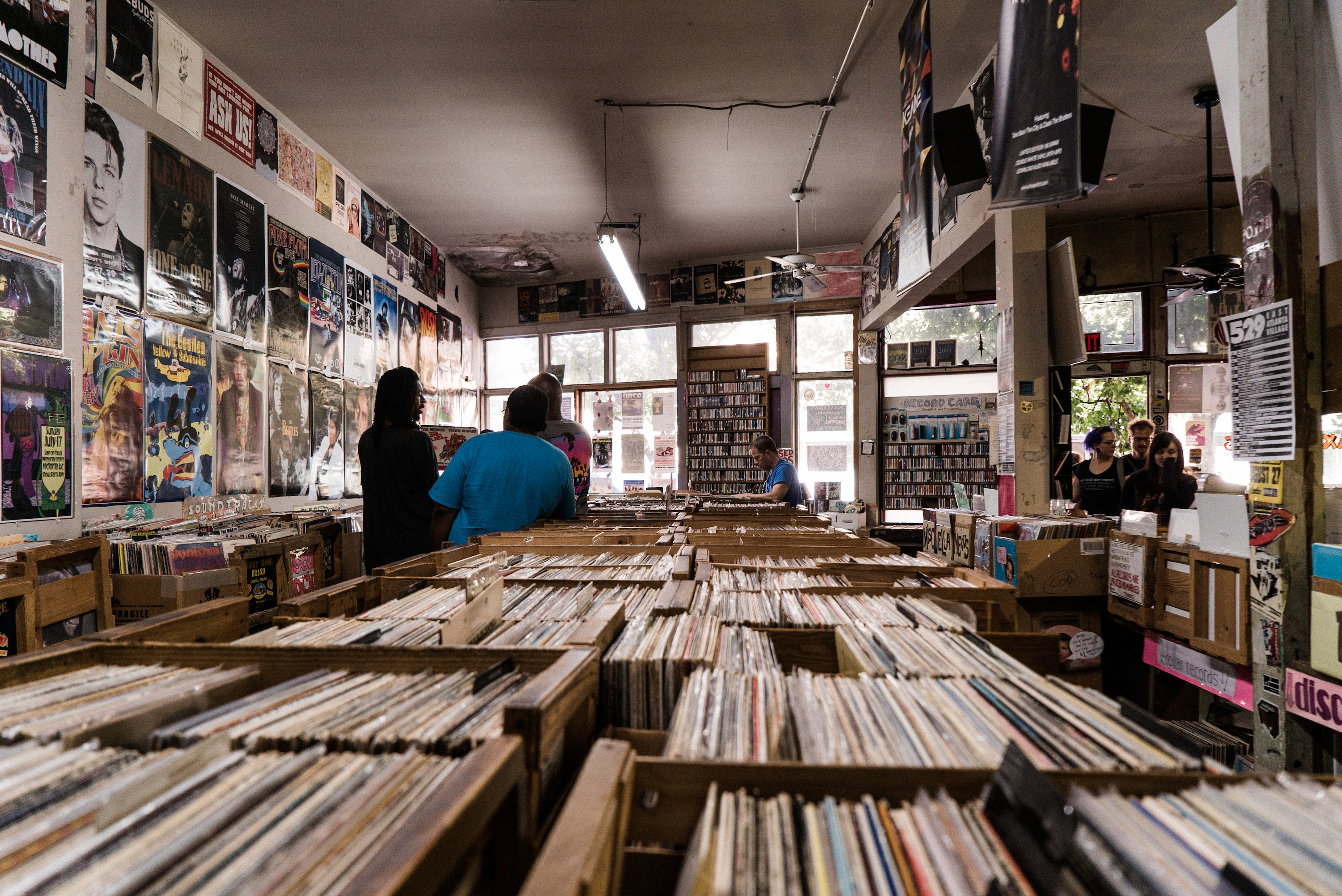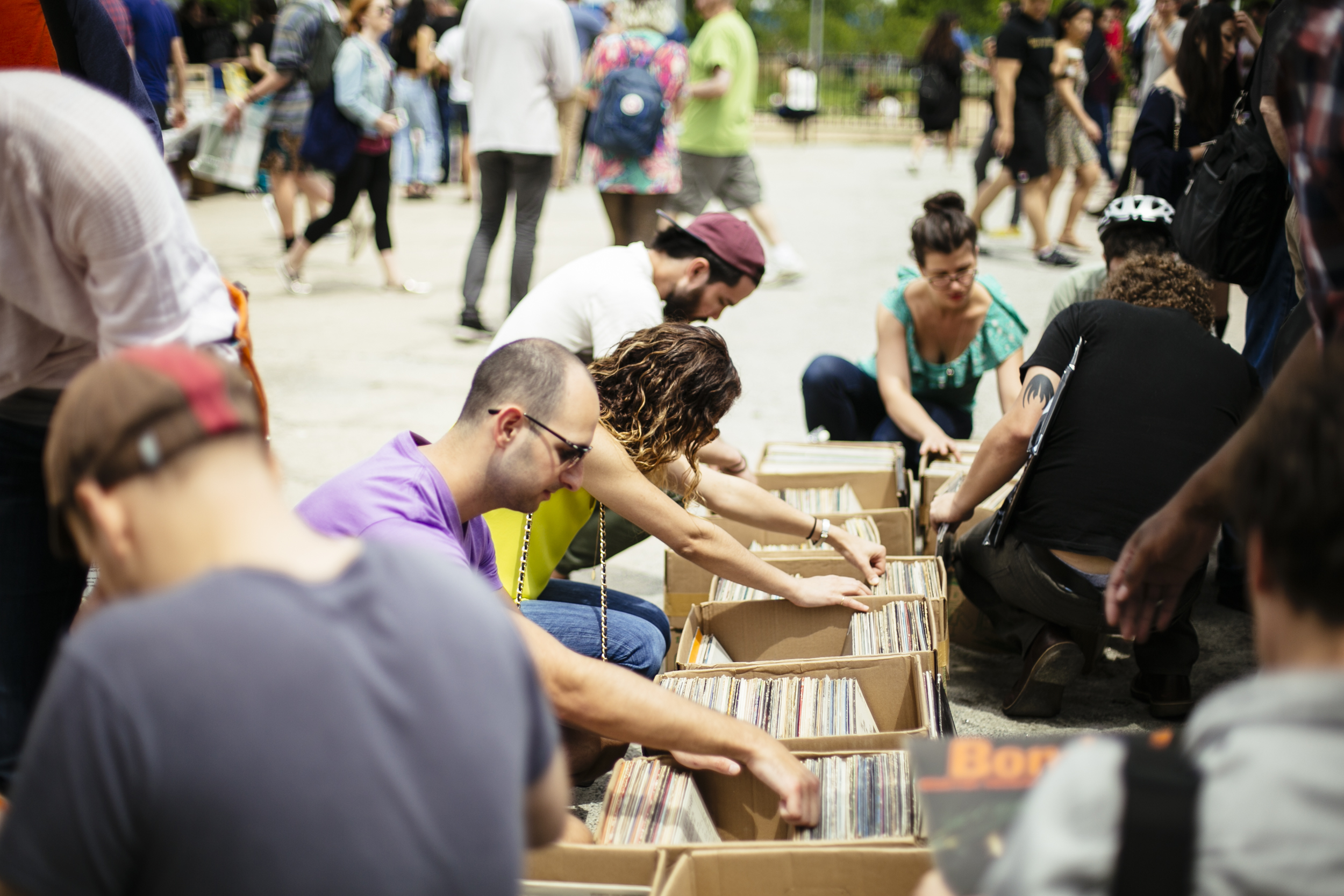Digging Through The Stacks at The Thing
William Burnett AKA Willie Burns shares anecdotes plucked from life in the trenches of this one-of-a-kind record shop

The Thing is, for all intents and purposes, a junk shop – the Greenpoint, Brooklyn institution is piled high with scuffed-up furniture, moth-eaten clothes, vintage porno magazines and scrap-heap stereo components. But since opening in the late ‘90s, the Thing has also developed a reputation as a gargantuan record-digging spot, with a back room and basement that could house as many as a million records; there’s no stock list to speak of, so no one knows for sure. Whatever your estimate, the collection is awe-inspiring, as much for its size as its sheer disorganization and griminess. (Regular customers know that surgical gloves and dust masks are a must for those planning to do more than a walk-through.)
William Burnett, who’s been in charge of vinyl at the Thing since the mid-’00s (in addition to running W.T. Records and producing under names like Willie Burns, Speculator and Black Deer), maintains a kind of willful ignorance about the contents of the collection he oversees – since every record costs $2 regardless of what it’s trading for on Discogs, he sees it as his duty to treat all of them exactly the same. In this interview with Jordan Rothlein for Red Bull Radio’s Counter Intelligence, Burnett remembers his first encounter with the imposing basement, estimates the collection’s total number and shares stories of the good, bad and ugly clientele that make working at the Thing a continuously interesting proposition.

Origins
In the 1940s and ’50s this store, 1001 Manhattan Avenue in Brooklyn, New York, was an ice cream shop. Then it was a junk store, and then I think somewhere around ’96, ’97, a new owner bought this place. He kept some of the junk in here, and then started filling it up with extra records from his record store, extra books and other stuff that he had bought in auctions. They had all the records on pallets in the basement stacked on their side. Then Angry Jay, he’s the DJ in the rollerskating thing in Central Park, built all the shelves. It slowly became a store after that.
One day I was walking down the street carrying some records and I ran into this guy, he was a soul DJ and he said, “Oh, do you know about this place?” I came straight here and was like, “Holy moly. This is quite a few records.” I started coming here every day. I always left it clean and I organized all the records. At that time one of my best friends had just moved here from Spain and he needed a job, so I suggested they hire him. He got a job and I kept coming as a customer and then one day I finally met the owner. He was like, “Oh yeah, this guy’s okay.”
The Employees
The people that work at The Thing are a strange group. We fly under the radar. Some of the people prefer to use fake names. Frankenstein, one of the guys that’s been here longer than me, is kinda the manager, [or] as we like to say, the main guy. He’s in some classic punk rock bands but he would never tell you that unless you hold him down. He comes in and he climbs around on the junk and throws stuff everywhere and runs around and whistles and listens to Poison and Primus and Guns N’ Roses and stuff like that.
There have been discussions about how many records there are and I think there’s close to 750,000.
There’s a couple other rocker guys – one’s Duff, one’s Jack. Duff does the clothes – not willingly, but he just likes to hide in the clothes. We’re both from Texas so we’re the only ones that actually work. Jack’s a newer addition, he’s in a band with Duff. He’s from Long Island or Queens or one of those, I get them mixed up. He’s a rocker/drummer dude. I think he drinks [that] Marky Mark water.
The Collection
There have been discussions about how many records there are [here] and I think there’s close to 750,000. Some people say, “No way, that’s way too much,” [but] if you think about it, a crate is about 100 records depending on how stuffed it is. Ten crates is 1000 records. You start doing the math and then see how filled up the entire back of the store is, walled in. Two rows out of the bottom are just solid records, plus the ones on the shelves and the ones in the aisles. I would guess between 500,000 and 750,000 records.
I’ve been trying to implement a system where there’s kind of a flow where newest arrivals arrive upstairs in the back. I kind of try to go through them and take out the complete garbage, the destroyed records, and put [in] some more interesting stuff. There’s a bin in the back for people who don’t feel like moving crates, you can flip through [it] easily. I put the newest and most interesting stuff in there. After that the records go from outside of the room into the back where the listening station is, to downstairs on the side by the 45s room and then they kind of slowly shift towards the back where the exit to the street is. There’s kind of a flow but sometimes I’m not here for a little bit and they’ll just put them wherever.


When people come to ask if they can find something, I just say, “Records are two dollars.” There’s no answer. Maybe by chance I put it in the bin, but generally there’s no organization at all. There’s a couple things like if someone’s looking for Latin records I know there’s a guy who has a Latin record stash and I know where he puts them all together when he finds them, which is I guess kind of helpful, and I send people there. That’s about it. I know where the 45s are. I know where the 78s are. It’s too many.
The gist of the record collection tends to be more DJ collections. You get more of a focus on 12" singles, but it could be any type of music that someone would DJ with. You get disco, ’80s, ’80s dance, ’90s house and now we’re starting to get ’90s trance. Then you get 2000s hip-hop, but then in between there will still be Barbra Streisand, Johnny Mathis, Rod Stewart, Donna Summer, all the million-sellers in there.
Every single 12" disc is two dollars. 7"s are two for a dollar. 78s depends on who’s working; they could be one dollar, they could be two. Maybe if you buy a whole lot you get some bucks off, but if you’re a jerk then you don’t.
The interesting thing for me is that these are records that people do not want. To bring them back to life and get this second life out of them, it’s really special for me. You know you go through these major label records that were pressed, maybe they have a hit on them, but maybe Farley “Jackmaster” Funk has a remix on it. That’s kind of what I think is the most interesting stuff out here. Also, you can just really educate yourself. You can get every single ’70s and ’80s R&B, soul, Motown, they’re all here. You can go through and listen to them all. Maybe there’s an album cut that nobody’s playing, the Pointer Sisters or Patti LaBelle. These million-sellers that you would play at an underground party. My aunt would know the song, but the kid at the party in Berlin thinks it’s the most underground, obscure disco cut ever. That’s kind of what the Thing is about for me.
The Clientele
The regular customers are the people from the neighborhood who come in for the junk and books and bric-á-brac, and dealers that come in to buy a lot of stuff and spend a lot of money, or neighborhood people who come in to buy books. Then you have the record people. There’s several types. Lately it seems like mostly people are here to resell records. They’re buying records that are valuable, not records of the music they like. There’s a split there between the dealers and the consumers. The dealers have their whole set-up going, their masks and their bags and their turntables and their phone and their extra battery. They sit there and they go through everything and look for stuff in perfect condition. They know what it is right away and they don’t need to look it up, or instead of listening to it they look them up on the phone to see if it’s worth money. Then there’s DJs and and home collectors who enjoy music, regular people [who] come in to buy records and sit at home and listen to or play for their friends.
There’s a really terrible guy that comes once a year from Montréal. This year he wore an entire spacesuit, dust suit, and he put bags on his shoes and taped them and had a full mask, like asbestos removal-style.
As far as [well-known DJs] that shop at the Thing the only one that still comes quite regularly is Frankie Bones. He’s been here slinging records, like Discogs, batches of records. He comes in, he’s polite, he goes hard, buys $50 or $100 worth of records every time, goes back to Jersey. I think he’s been coming here since the beginning. There’s a few regulars. There’s a guy, Paul, who even worked here for a little while. He doesn’t work here anymore but he comes and he’s got his mask on and he goes pretty hard, too. Hip-hop and classical are now in the field for resale where people can actually make money. There’s a lot of Latin guys buying Latin records now. I can sort of talk to them but I haven’t gotten deep into them, a lot of them only speak Spanish. That seems to be a bigger thing now.
There’s a really terrible guy that comes once a year from Montréal. He rides the bus and he sits here all day. This year he wore an entire spacesuit, dust suit, and he put bags on his shoes and taped them and had a full mask, like asbestos removal-style. He made a huge mess and you would go and tell him to clean up and he would say, “Yeah, I’m cleaning it up” and then he just wouldn’t. After four days he scared everyone away because it looked like a hazardous environment. He came up and tried to buy the records and I was really hard on him with the price because he’s such a jerk, he’s kind of a man-baby, like most people that shop here. He finally somehow miraculously came up with an extra hundred dollar bill and was able to leave with all his records.
In this neighborhood there used to be a hotel where there were murders and stuff like that. Those people would come by. They were kind of like one step above homeless. When they get their check once a month they’ll buy something stupid that they shouldn’t buy, for whatever reason. We also have a halfway house for people who don’t have anywhere to go after they get out of jail five blocks away. Those people always think we’re a pawn shop. Other bad things [have happened], like finding gross stuff in the basement. Someone had gone number two on the floor and then thought it was a good idea to put a record on top and then put a crate on top. I’m down there cleaning and I’m like, “Why is this record stuck to the floor?”
Lately I’ve been working on the weekends [and] there’s a new brunch place next door, so we get the brunch crowd. They stand around and hold their coffee or their phone and take pictures of stuff and giggle at the porno and maybe they buy a ’60s Playboy or a book. Other neighborhood people? Plenty of nice people, but you don’t ever remember them, you know.
The Value
The thing about finding records that are super expensive is that I don’t know what records are super expensive. It’s kind of stupid that I don’t, but I don’t. The one record that I was looking for for a long time that I knew was in here was the Quality [Records] pressing of [A Number of Names’] “Sharevari.” I kept seeing people pull it out of here and I never had it, and one day I pulled one of it and it was sealed and I was like, “Yes, finally.”
I have no idea what stuff is worth. I don’t ever go home and look [it up] because if I started doing that then I would maybe develop a conflict of [interest] kind of thing, start looking for expensive records myself and going home and slanging them. I don’t know, it wouldn’t be right. It’s not really my forte, plus I could never sell records online. The most terrible people buy records online. “Oh my God, there’s a pencil mark on my label.” Get out of here. I just wouldn’t be able to say polite things back to them.

